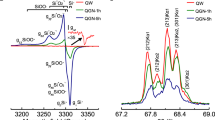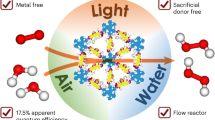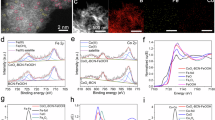Abstract
Over the past decade numerous lineages of bacteria have been shown to obtain energy for growth through redox transformations of arsenic. However, phototrophic growth using reduced arsenic as an electron donor has not been described. Here we report the light-dependent oxidation of arsenite to arsenate, coupled with autotrophic growth, by an Ectothiorhodospira-dominated consortium of bacteria from alkaline, hypersaline Mono Lake, California. Pure cultures of the Mono Lake Ectothiorhodospira were not capable of phototrophic arsenite oxidation under the culture conditions tested. Electron micrographs of the culture showed a close association between consortia members, although the specific contribution of the individual bacteria is currently unknown. This report extends the list of compounds known to support anoxygenic photosynthesis and documents a previously unknown pathway in arsenic geochemistry.
Similar content being viewed by others
Log in or create a free account to read this content
Gain free access to this article, as well as selected content from this journal and more on nature.com
or
References
Brune DC . (1989). Sulfur oxidation by phototrophic bacteria. Biochim Biophys Acta 975: 189–221.
Cloern JE, Cole BE, Oremland RS . (1983). Seasonal changes in the chemistry and biology of a meromictic lake (Big Soda Lake, Nevada, USA). Hydrobiologia 105: 195–206.
Domagalski JL, Eugster HP, Jones BF . (1990). Trace metal geochemistry of Walker, Mono, and Great Salt Lakes. In: Spencer RJ, Chou IM (eds). Fluid-Mineral Interactions: A Tribute to HP Eugster. The Geochemical Society: San Antonio, TX, USA, Special Publication No. 2. pp 315–354.
Grant WD, Mwatha WE, Jones BE . (1990). Alkaliphiles: ecology, diversity and applications. FEMS Microbiol Rev 75: 255–270.
Griffin BM, Schott J, Schink B . (2007). Nitrite, an electron donor for anoxygenic photosynthesis. Science 316: 1870.
Heising S, Richter L, Ludwig W, Schink B . (1999). Chlorobium ferrooxidans sp. nov., a phototrophic green sulfur bacterium that oxidizes ferrous iron in coculture with a ‘Geospirillum’ sp. strain. Arch Microbiol 172: 116–124.
Hoeft SE, Kulp TR, Stolz JF, Hollibaugh JT, Oremland RS . (2003). Dissimilatory arsenate reduction with sulfide as electron donor: experiments with Mono Lake water and isolation of strain MLMS-1, a chemoautotrophic arsenate respirer. Appl Environ Microbiol 70: 2741–2747.
Hollibaugh JT, Carini S, Gurleyuk H, Jellison R, Joye SB, Lecleir G et al. (2005). Arsenic speciation in Mono Lake, California: response to seasonal stratification and anoxia. Geochim Cosmochim Acta 69: 1925–1937.
Huber R, Sacher M, Vollmann A, Huber H, Rose D . (2000). Respiration of arsenate and selenate by hyperthermophilic archaea. Syst Appl Microbiol 23: 305–314.
Imhoff JF . (2006). The family Ectothiorhodospiraceae. In: Dworkin M, Falkow S, Rosenberg E, Schleifer K-H, Stackebrandt E (eds). The Prokaryotes, 3rd edn. Springer: New York. pp 874–886.
Maest AS, Pasilis SP, Miller LG, Nordstrom DK . (1992). Redox geochemistry of arsenic and iron in Mono Lake, California. In: Kharaka YK, Maest AS (eds). Water-Rock Interactions. AA Balkema: Rotterdam, The Netherlands. pp 507–511.
Oremland RS, Hoeft SE, Santini JM, Bano N, Hollibaugh RA, Hollibaugh JT . (2002). Anaerobic oxidation of arsenite in mono lake water by a facultative, arsenite-oxidizing chemoautotroph, strain MLHE-1. Appl Environ Microbiol 68: 4795–4802.
Oremland RS, Stolz JF, Hollibaugh JT . (2004). The microbial arsenic cycle in Mono Lake, California. FEMS Microbiol Ecol 48: 15–27.
Oscarson DW, Huang PM, Liaw WK . (1980). The oxidation of arsenite by aquatic sediments. J Environ Qual 9: 700–703.
Roesler CS, Culbertson CW, Etheridge SM, Goericke R, Kiene RP, Miller LG et al. (2002). Distribution, production, and ecophysiology of Picocystis strain ML in Mono Lake, California. Limnol Oceanogr 47: 440–452.
Salmassi TM, Walker JJ, Newman DK, Leadbetter JR, Pace NR, Hering JG . (2006). Community and cultivation analysis of arsenite oxidizing biofilms at Hot Creek. Environ Microbiol 8: 50–59.
Santini JM, Sly LI, Schnagl RD, Macy JM . (2000). A new chemolithoautotrophic arsenite-oxidizing bacterium isolated from a gold mine: phylogenetic, physiological, and preliminary biochemical studies. Appl Environ Microbiol 66: 92–97.
Stolz JF, Basu P, Santini JM, Oremland RS . (2006). Arsenic and selenium in microbial metabolism. Annu Rev Microbiol 60: 107–130.
Widdel F, Schnell S, Heising S, Ehrenreich A, Assmus B, Schink B . (1993). Ferrous iron oxidation by anoxygenic phototrophic bacteria. Nature 362: 834–836.
Acknowledgements
This work was made possible by a grant from the National Science Foundation (MCB 99-77886). We thank G LeCleir for collecting and incubating the sediment, M Madigan for supplying a culture of Ectothiorhodospira sp. strain ‘Bogoria Red,’ and M Farmer and J Shields for help with scanning electron microscope. Discussions with R Oremland inspired this work. W Whitman, J Wiegel and two anonymous reviewers provided helpful suggestions on earlier drafts of the paper.
Author information
Authors and Affiliations
Corresponding author
Additional information
Supplementary Information accompanies the paper on The ISME Journal website (http://www.nature.com/ismej)
Supplementary information
Rights and permissions
About this article
Cite this article
Budinoff, C., Hollibaugh, J. Arsenite-dependent photoautotrophy by an Ectothiorhodospira-dominated consortium. ISME J 2, 340–343 (2008). https://doi.org/10.1038/ismej.2007.115
Received:
Revised:
Accepted:
Published:
Issue date:
DOI: https://doi.org/10.1038/ismej.2007.115



